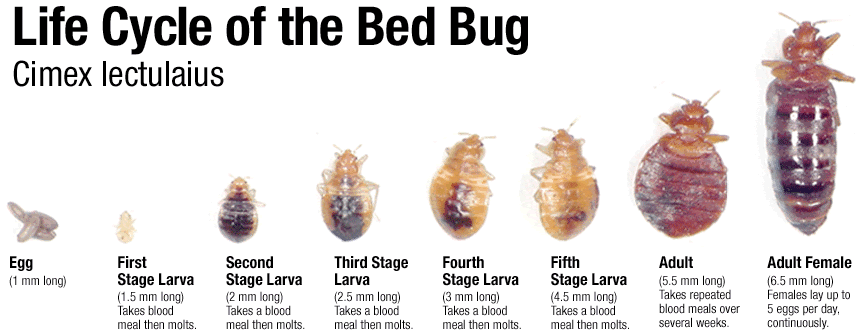|
 |
|
|
|
|
| Comprehensive Bed Bug control information |
History And Life Cycle The bed bug is an old pest that was common in homes prior to World War II. For the last 50 years, bed bugs
have rarely been seen outside of cramped living quarters and less than sanitary conditions in jails and homeless shelters. Not anymore.
In the last five years there has been a resurgence. Bed bugs have become a particular problem in hotels, motels, and hostels where
there is a high rate of occupant turnover. Even five star hotels are having problems with bed bugs.
Bedbugs are 5-7 mm in length with reduced wings. The mouthparts are modified for piercing and sucking. They live between wooden
floorboards or in furniture, bed frames, mattresses, or behind peeling paint. The bedbug sneaks out to grasp human skin with its forelegs, pierces the
skin, and injects anticoagulant- and anesthetic-containing saliva. Bedbugs normally feed at night, usually about an hour before dawn, but if the
conditions are favorable, they also feed during the day. Feeding time takes from 3-12 minutes. Adult bedbugs can survive starvation in proper conditions
for a year or more. Each female lays about 300 eggs in her lifetime. The eggs hatch in 10 days. The nymph stage lasts 6 weeks, undergoing 5 molts.
Some Basic Facts:
- Bed bugs are persistent. Eradicating, exterminating or just killing an entire infestation requires persistence.
- Bed bugs can hide in extremely small cracks and crevices making it difficult to locate breeding sites.
- Bedbugs are rarely seen in daylight. They emerge from their hiding spots at night.
- Bed bugs can live a year or longer without food (blood) and thus stay in their hiding places.
- Bed bugs can travel long distances and survive in suitcases, clothing, vehicles, aircraft, cruise ships and other modes of transportation.
- Bed bug females lay about 300 eggs.
- Bed bugs hatch from eggs in 10 days.
Bed Bug Bites:
Bed bugs feed by piercing skin with an elongated beak. Saliva is injected, containing an anesthetic to reduce pain, and an anticoagulant to keep blood
flowing. The reaction to bed bug bites varies among individuals, from no reaction to sever skin inflammation and irritation.
Symptoms of a Bed Bug Infestation:
Most bug bug problems are not detected until someone has been bitten. The bite is painless. The salivary fluid injected by bed bugs typically causes
the skin to become irritated and inflamed, although individuals can differ in their sensitivity. A small, hard, swollen, white welt may develop at the
site of each bite. This is accompanied by severe itching that lasts for several hours to days.
A bed bug infestation can be recognized by blood stains from crushed bugs or by rusty (sometimes dark) spots of excrement on sheets and mattresses,
bed clothes, and walls. Fecal spots, eggshells, and shed skins may be found in the vicinity of their hiding places. An offensive, sweet, musty odor
from their scent glands may be detected when bed bug infestations are severe.
Hiding Places
Bed bugs can live in almost any crevice or protected location. They will usually stay close to their food source
(blood) but can rapidly spread through a multiple residence building, hotel or other accommodations. The most common place to find them is the bed.
Bed bugs often hide within seams, tufts, and crevices of the mattress, box spring, bed frame and headboard.
Finding Bed Bugs
Some Bed bug symptoms are not obvious to the untrained eye. A thorough inspection requires dismantling the bed and standing the components on edge. Things
to look for are the bugs themselves, and the light-brown, molted skins of the nymphs. Dark spots of dried bed bug excrement are often present along
mattress seams or wherever the bugs have resided. Oftentimes the gauze fabric underlying the box spring must be removed to gain access for inspection and
possible treatment. Successful treatment of mattresses and box springs is difficult, however, and infested components may need to be discarded. Cracks and
crevices of bed frames should be examined, especially if the frame is wood. (Bed bugs have an affinity for wood and fabric more so than metal or plastic).
Headboards secured to walls should also be removed and inspected. In hotels and motels, the area behind the headboard is often the first place that the
bugs become established. Bed bugs also hide among items stored under beds. Nightstands and dressers should be emptied and examined inside and out, then
tipped over to inspect the woodwork underneath. Oftentimes the bugs will be hiding in cracks, corners, and recesses.
Upholstered chairs and sofas should be checked, especially seams, tufts, skirts, and crevices beneath cushions. Sofas can be major bed bug hotspots when
used for sleeping. Other common places to find bed bugs include: along and under the edge of wall-to-wall carpeting (especially behind beds and furniture);
cracks in wood molding; ceiling-wall junctures; behind wall-mounts, picture frames, switch plates and outlets; under loose wallpaper; amongst clothing
stored in closets; and inside clocks, phones, televisions and smoke detectors.
The challenge is to find and treat all places where bugs and eggs may be present. Bed bugs tend to congregate in certain areas, but it is common to find
an individual or some eggs scattered here and there. Persistence and a bright flashlight are requisites for success. Professional Inspectors sometimes
also inject a pyrethrum-based, "flushing agent" into crevices to help reveal where bugs may be hiding. A thorough treatment of a home, hotel, or
apartment may take several hours or days.
|
 |
|
|
|
|
|
|
|
|
|
